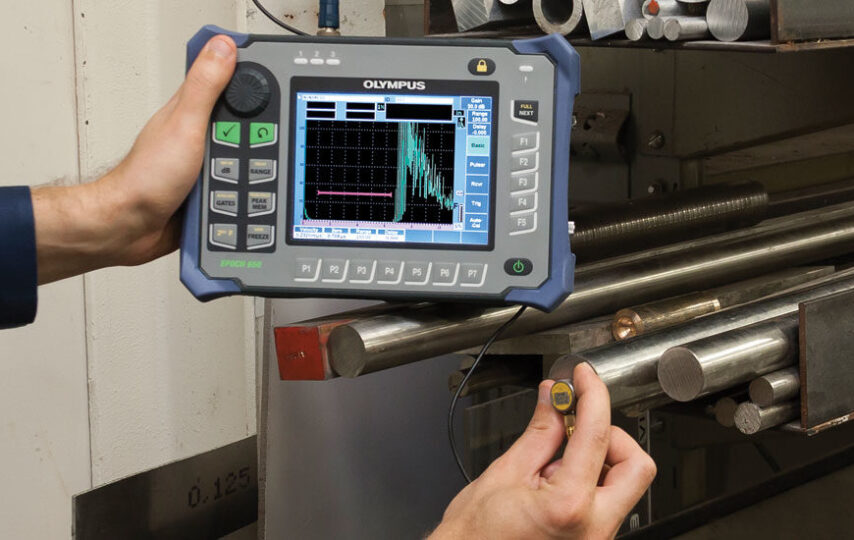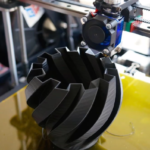Ultrasonic Testing (UT) is a powerful and versatile non-destructive testing (NDT) technique that uses high-frequency sound waves to examine materials for discontinuities such as cracks, voids, foreign objects such as slag inclusions or particles in metals. It is also used to measure thicknesses and distances. UT is widely used in the aerospace, automotive, and manufacturing industries to detect and characterize flaws in a wide variety of materials, including ceramics, plastics, and metals.
To perform an ultrasonic test, a couplant is first applied to the surface of the material being tested. The couplant helps carry the ultrasonic waves from the transducer to the tested material.
Ultrasonic waves are generated by an phased array transducer, which transmits the waves into a material. When these waves encounter an imperfection in the material, they are reflected back and detected by the transducer. A computer analyzes the resulting signals to create an image of the defect. The time it takes for the wave to travel from the transmitter to the receiver is used to calculate the distance to the imperfection.
Sonogram vs. Ultrasound
Sonogram vs. Ultrasound: You may have heard the words “sonogram” and “ultrasound” used interchangeably, and it’s easy to get the two confused. What do these terms mean exactly, and how are they different? In this post, we’ll clarify the meaning of these easy-to-confuse words and provide some information about both. If you want to learn more about imaging procedures, we’ll be happy to assist you at Health Images.
From that simple breakdown, a couplant plays a major role in ultrasonic testing. But what exactly is a couplant?
- What is Couplant in Ultrasonic Testing?
The term “couplant” refers to any material used to provide the necessary coupling effect between the sound wave energy produced by the ultrasonic probe and the structure being tested.
It is usually a liquid or semi-solid medium, which helps transmit the ultrasonic energy more efficiently than air. It can also help to minimize any interference and improve acoustic impedance that might occur between the transducer and the surface of the object being inspected.
The most commonly used couplant for ultrasonic testing is glycerine. Other materials that are sometimes used include water, silicone grease, gel, and oils. The different types of liquids have their own unique properties, making them better suited for specific uses.
- Types of Couplant in Ultrasonic Testing
In many instances, everyday substances like water, motor oil, lubricant, and even commodities like hair gel are utilized as ultrasonic couplants. However, specifically designed couplants are required for optimum high-temperature and conventional acoustic impedance tests. The following is an overview of the different types of couplants available:
Gel Based
Gel-type couplants are frequently advised for uneven surfaces like sand-cast metals and fiberglass layups. Their high viscosity and comparatively high acoustic impedance can optimize sound coupling when the transducer cannot establish smooth contact with the test surface.
Gel couplants are commonly used in welding assessments where you need to slide the transducer across a large surface area. The benefit here is that the gel can be dispersed over a vast area quickly and still maintain strong coupling as the transducer is run along the weld.
The viscosity of gel allows use on overhead and vertical surfaces. Gel couplants also have a high operating temperature limit and are slow drying.
Glycerin Based
Glycerin is thick and has a high acoustic impedance, making it an ideal ultrasonic couplant for rough and highly attenuating surfaces. The acoustic impedance of glycerin is 2.42 kg/m2s x 106. (versus 1.61 for propylene glycol, approximately 1.5 for motor oil, and 1.48 for water) similar to that of polymers.
It applies better on metal than other popular coupling liquids, allowing for better sound transmission between the transducer and the test item. When contrasted to propylene glycol, glycerin typically delivers a 3 to 6 dB boost in signal strength in metal testing.
The downside of glycerine is that it absorbs and holds moisture from the atmosphere. This can induce rusting or corrosion in some metals if it is not cleared after use, and it can also facilitate microbial contamination. Therefore, wash it away after each use. However, its use with plastics, fiberglass, or composites does not elicit corrosion fears. Do not heat glycerine above 200 degrees Fahrenheit (90 degrees Celsius).
Silicone-based Couplant
Silicone-based couplants have higher temperature resistance (775 Fahrenheit), which makes them ideal for applications that include high-temperature thickness gaging and flaw detection, as well as ambient and low-temperature coupling, where corrosion, wide material compatibility, long service life, and low toxicity are not issues. Other properties that make it a good ultrasonic couplant include its high viscosity and good wetting properties.
Water
Water is not widely used as an ultrasonic couplant since it has a relatively lower operating temperature range, it dries faster, and it causes corrosion in most metals. Water is also impractical as a couplant for ultrasonic testing that requires full immersion of the specimen as it drips off or dries up immediately.
- Why is Couplant Used in Ultrasonic Testing?
Couplant is used in ultrasonic testing to improve the sound transmission between the transducer and the specimen. Without couplant, ultrasonic waves would be largely absorbed by air gaps between the two surfaces.
Apart from attenuation impacts, the air has a significant acoustic impedance between the transducer waveplates and test substances. Even a small air gap between the transducer and the test piece prevents optimal sound energy transmission, as it would decrease the signal-to-noise ratio, making it more difficult to obtain an accurate reading.
Couplant also helps to provide a smooth surface on which the ultrasound waves can travel. If there are any irregularities on the surface of the specimen, this can cause reflections and scattered waves that degrade the image quality. By using an ultrasonic couplant, these reflections and scattered waves are reduced, resulting in a cleaner ultrasound image.
Conclusion
Ultrasonic testing is a reliable, cost-effective way to inspect for defects in a variety of objects
Couplant is a necessary part of the ultrasonic testing process. Without it, the test might not be as reliable and may provide inaccurate or incomplete information about an object’s condition or composition.








